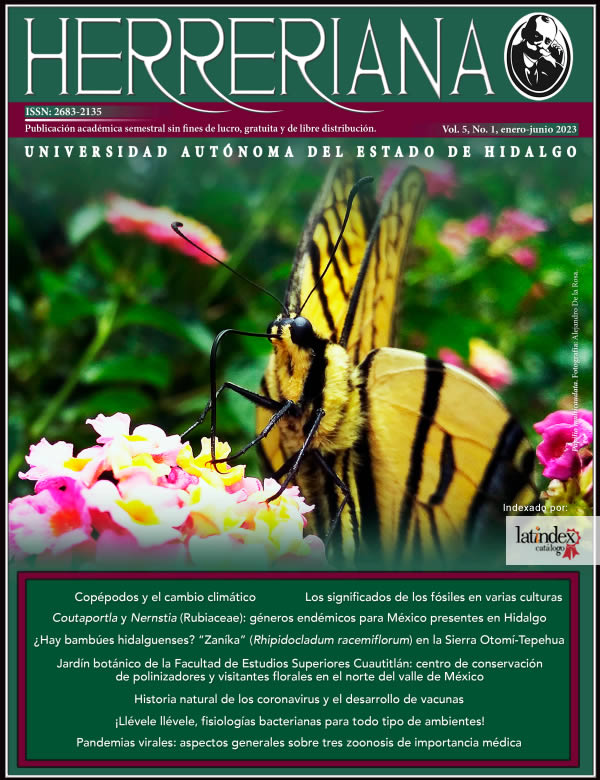Viral pandemics: General aspects of three zoonoses of medical importance
DOI:
https://doi.org/10.29057/h.v5i1.8564Keywords:
zoonoses, molecular diagnostic, epidemiology, pandemicAbstract
The current situation faces us with a health problem of global proportion, understanding the general implications of a viral pandemic will allow a better comprehension of the processes that generate them. This work shows historical aspects about the emergence of three pandemic viral zoonoses. In addition, shown the standardized methods of diagnostic and relevant social and economic aspects to understand the impact that this type of disease has on humanity. If currently only 0.1% of the viruses’ diversity that affect mammals is known, there is a high probability that the next pandemic will be among those unknown viruses.
Downloads
Publication Facts
Reviewer profiles N/A
Author statements
Indexed in
- Academic society
- N/A
- Publisher
- Universidad Autónoma del Estado de Hidalgo
References
Barré-Sinoussi, Françoise 2018. L'infection VIH / sida: l'histoire exemplaire d'une épidémie qui résiste. Sciences médicales, 34(6-7), 499-500.
Baseler, L., Chertow, D. S., Johnson, K. M., Feldmann, H. & Morens, D. M. 2017. The pathogenesis of Ebola virus disease. Annual Review of Pathology, 12, 387-418.
Cabrera, A. 2015. Estado actual de la circulación de hantavirus en Uruguay. Tesis de maestría. Universidad de la República (Uruguay). Facultad de Ciencias.
Celis, B. W. Y., Ariza, D. J. & Murillo, M. L. M. 2018. Sistemas de información para vigilancia de enfermedades zoonóticas, Revisión de Literatura. Tesis de Licenciatura en Medicina Veterinaria y Zootecnia. Facultad de Medicina Veterinaria y Zootecnia, Universidad Cooperativa de Colombia, Bucaramanga, Colombia.
Dhama, K., Singh, M. Y., Sing, M. S. V. & Kumar, S. R. 2015. Ebola from emergence to epidemic: the virus and the disease, global preparedness, and perspectives. The Jorunal of Infection in Developing Countries, 9(5), 441-455.
DeCandia, A., Dobson, A. P. & vonHoldt, B. M. 2018. Toward an integrative molecular approach to wildlife disease. Conservation biology: the journal of the Society for Conservation Biology, 32(4), 798-807.
Devine, G. J., Eza, D., Ogusuku, E. & Furlong, M. J. 2008. Uso de insecticidas: contexto y consecuencias ecológicas. Revista Peruana de Medicina Experimental y Salud Pública, 25(1), 74-100.
Elston, J. W. T., Cartwright, C., Ndumbi, P. & Wrigth, J. 2017. The health impact of the 2014-15 Ebola outbreak. Public Health, 29(12), 1517-1532.
Fuentes, C. M., Pérez. G. L., Suárez, H. Y., Soca, P. M. & Martínez, M. A. 2006. La zoonosis como ciencia y su impacto social." REDVET Revista Electrónica de Veterinaria, 7(9), 1-19.
Hin-Fung, T., Wing-Chi, L., Chiu-Hung, T. J., Wong, H-T, Koon-Chi, C., Chi-Chuen, A. T., Kit-Ching, C. A., Po-Wah, N. L., Chi-Shing, C. W. & Sze-Chuen, C. W. 2018. Implementation and new insights in molecular diagnostics for HIV infection. Expert Review of Molecular Diagnostics, 18(5), 433-441.
Hong, K. H., Shang, W: L., Taek, S. K., Hee, J. H., Jaehyeon, L., So, Y. K., Jae, S. P., Gab, J. K., Heungsup, S., Kyoung, H. R., Jae, S. K., Hyun, S. K., Seung, T. L., Moon, W. S., Namhee, R., Hyukmin, L., Kye, C. K. & Cheon, K. Y. 2020. Guidelines for laboratory diagnosis of coronavirus disease 2019 (COVID-19) in Korea. Annals of Laboratory Medicine, 40(5), 351-360.
John Hopkins University. 2022. Coronavirus Resource Center. COVID-19 Dashboard. https://coronavirus.jhu.edu/map.html
Kaushik, A., Tiwari, S., Javant, R. D., Marty, A. & Nair, M. 2015. Towards detection and diagnosis of Ebola virus disease at point-of-care. Biosense and Bioelecton, 75, 254-272.
Malvy, D., McElroy, A. K., Clerck, H., Günter, S. & van Griensven, J. 2019. Ebola virus disease. Lancet, 393(10174), 936-948.
Navea, L. L. M., Lobaina, B. L., Dubed, E. M., Alvarez, S. G., Gómez, R. C. & Duarte, C. C. 2000. Neutralizing antibodies to 5 HIV-1 strains in macaques immunized with the multi-epitope polypeptide TAB9. Revista Cubana de Medicina Tropical, 52(2), 115 - 8.
Nicastri, E., Kobinger, G., Vairo, F., Montaldo, C., Mboera, L. E. G., Ansunama, R., Zumla, A. & Ippolito, G. 2019. Ebola Virus Disease: Epidemiology, Clinical Features, Management, and Prevention. Infect Disease Clincal North America, 33(4), 953-976.
Nicola, M., Alsafi, Z., Shorabi, C., Kerwan, A., Al_Jabir, A., Losifidis, C., Agha, M. & Agha, R. 2020. The socio-economic implications of the coronavirus pandemic (COVID-19): A review. International Journal of Surgery, 78, 185-193.
OMS. 2020. Organización Mundial de la Salud OMS, Zoonosis y medio ambiente. https://www.who.int/es/news-room/fact-sheets/detail/zoonoses
Pérez, A. M. R., Gómez, T. J. J. & Dieguez, G. R. A. 2020. Características clínico-epidemiológicas de la COVID-19. Revista Habanera de Ciencias Médicas, 19:2.
Probst, C., Parry, C. D. H. & Rehm, J. 2016. Socio-economic differences in HIV/AIDS mortality in South Africa. Tropical Medicine and Internal Health, 21(7), 846-55.
Ruiz, L. & Clotet, B. 1995. Transmisión sexual de cepas VIH-1 resistentes a la zidovudina. Medicina Clínica, 105(12), 476-7.
Santiago, M. L., Range, F., Keele, B. F., Li, Y., Bales, E., Bibollet-Ruche, F., Fruteau, C., Noë, R., Peeters, M., Brookfield, J. F. Y., Shaw, G. M., Sharp, P. M. & Hahn, B. H. 2005. Simian immunodeficiency virus infection in free-ranging sooty mangabeys (Cercocebus atys atys) from the Taï Forest, Côte d’lvoire: Implications for the origin of epidemic human immunodeficiency virus type 2. Journal of Virology, 79(19), 12515-12527.
Szyfres, B. 2003. Zoonosis y enfermedades transmisibles comunes al hombre y a los animales. Vol. 1. Pan American Health Org.


















